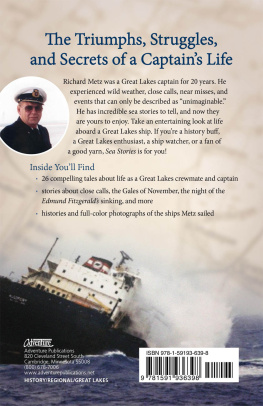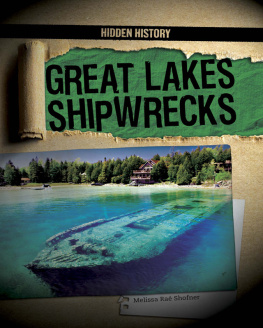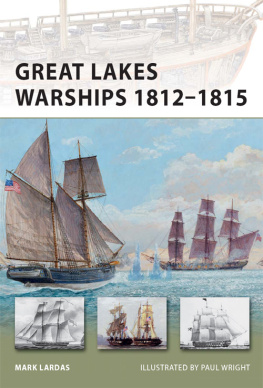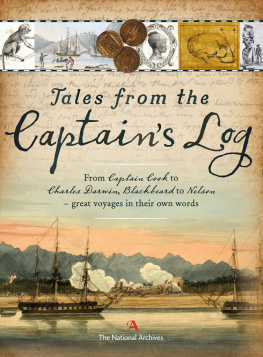
DEDICATION
I dedicate this book to the hundreds of seamen who were lost at sea and never made it back to shore and who are entombed and still standing their watch aboard their ships.
ACKNOWLEDGMENTS
I want to give thanks for my oldest friend, Vince Jordan, who got me interested in the boats; how he loaned me one hundred dollars to go to Duluth to get my first deckhand job on the S.S. Thomas Wilson . Years ago Vince taught me how to scuba dive. Without his teaching I probably would not have been a shipwreck diver or have written two books on diving and sailing the Great Lakes.
Thanks, Vince.
I also would like to give special thanks to one of my best friends, the late Stewart F. Belanger, who years ago encouraged me to write a book about my experiences at sea. Year after year when I came home from the lakes I would tell Stewart my sea stories. Year after year he would tell me to put my stories into book form. Thanks, Stewart, wherever you are.
Captain Richard D. Metz, 2017
Back cover photo courtesy of Boatnerd (www.boatnerd.com), photo of Captain Metz courtesy of Richard Metz
Photo credits listed on each image.
Cover and book design by Lora Westberg
10 9 8 7 6 5 4 3 2 1
Copyright 2017 by Richard Metz
Published by Adventure Publications
An imprint of AdventureKEEN
820 Cleveland Street South
Cambridge, Minnesota 55008
(800) 678-7006
www.adventurepublications.net
All rights reserved
Printed in China
ISBN: 978-1-59193-639-8; eISBN: 978-1-59193-760-9
TABLE OF CONTENTS
HOW IT USED TO BE
I started my sailing career on April 27, 196453 years ago. I started as an ordinary seaman aboard the Thomas Wilson . I retired in 1999 and am in my 80s now. There are not too many of us old guys around anymore.
The captains of today, with their 1000-footers and powerful diesel engines, have no idea what it was like in the 1960s. They will never experience any of the following:
- Sailing a ship that was built at the turn of the century, and ships that were only 500 or 620 feet long
- The labor involved in securing 35 telescopic sliding hatches, which were sealed with tarps, often frozen, and had to be wrestled into place by strong backs and batten boards
- Sailing aboard a ship with a steam engine powered by coal; a top speed of 8 knots with fly ash spewing all over the deck
- The thrill of being in a gale with the pilothouse forward and the bow hitting a high wave head-on; or the feeling of the bow going down into the trough of a wave and having the stern come entirely out of the water, the prop shaking the whole ship causing the engineer to cut the speed down; then, when the stern settled, giving the ship full steam ahead, so the bow would come up, plowing a wall of water over the pilothouse, a small heater in the front window the only thing preventing the window from freezing up
- In those days, there were no interior tunnels if you wanted to move through the ship during a storm; instead, there was a wire cable strung on the deck and leading from the pilothouse to the cabins; hooking up to the cable was the only way to ensure you wouldnt get washed off the deck
- The galley served fine food, including homemade bread, rolls, pie, and steak that was 1 inch thick
- The skipper had an old RCA radar and only used it in fog, but it was not very good, it took several minutes to make one complete sweep and by that time the target had disappeared until the next sweep; if you wanted to find a ships position, there was no GPS, you had to use radio direction finding
- Weather forecasts were announced twice daily at 0700 and 1900 hours on AM radios; now we get weather 24 hours a day, and it is far more accurate
- At the Soo Locks, we used all four locks and sometimes the Canadian Lock. Many times, we had to reduce our speed or anchor because of all the traffic. Once in the lock vendors with bikes used to come alongside of the ship selling papers, tobacco, and candy; not any more
- I used to climb up the forward or aft mast to change light bulbs, and in freezing weather climb up the rear ladder on the pilothouse to chip away ice so the radar scanner would rotate; there were no bow thrusters or twin screws to help with shiphandling, we had anchors and know-how
I am glad to have sailed the way we used to do it, but I would not mind going for a trip on a thousand-footer and seeing all of the new things they have today.

GREENHORN

Ship: Thomas Wilson
Rank: Deckhand
Year: 1964


The Thomas Wilson ; taken by Dick Metz
One night as I sat on a roll of paper during a break at my job at the paper mill, I was thinking about the lakeLake Superiorand I drew my thoughts on the paper. It was a large drawing of the lake, its islands, shipwreck locations, and the shipping routes from Duluth to the Soo Locks in Sault Ste. Marie, Michigan.
A coworker walked by and looked at my drawing. Thats very good, he said. Could I have it? I tore off the piece of paper and handed it to him.
Dick, you love the lakes so much, why dont you quit and get a job on the boats?
I thought about this for a few days and made up my mind. When I asked the foreman if I could have a few days off, he said, Yes, but for what?
To try to find out how to get a job on the boats.
Go ahead. He understood my feelings. I know your heart is set on the boats and not on this job.
Starting Out
I drove up to Duluth and registered with Mike Ross at the Lake Carriers Association Hiring Hall. Do you want to work in the engine room or as a deckhand? he asked.
Whats the difference? I had no idea.
Mike explained each job to me. When he finished, I didnt hesitate. I did not want to work where it was so hot, and I wanted to see where I was going. I want to be a deckhand, I said.
I drove back home, quit the mill, and packed my seabag.
About a week later, Mike called. Ive got a deckhand job that opened up on the Thomas F. Cole for United States Steel. Come on in to my office and Ill get you set up.
My friends gave me a going-away party. Big mistake; they should have had it without me. When I arrived at Mikes office, he took one look at me and said, What happened to you? Dont you know you have to take a physical for this company?
No, I didnt know. Ashamed, I went off to get my physical. I failed it, due to an elevated blood sugar level, an elevated heart rate and high blood pressure (otherwise known as a hangover).
I went aboard the anyway and asked for the Captain. A crewman led me to his quarters. We exchanged introductions, and the Captain sat down. I figured that since he sat down, it was okay for me to sit, too. When I did, there was a crunching noise. I moved to locate the source of the crunch, and discovered that I had sat on his glasses. Things are off to a bad start, I said to myself.
I told the Captain my story. Im not a drinker, I said, and I would like to work on your boat.
Next page












